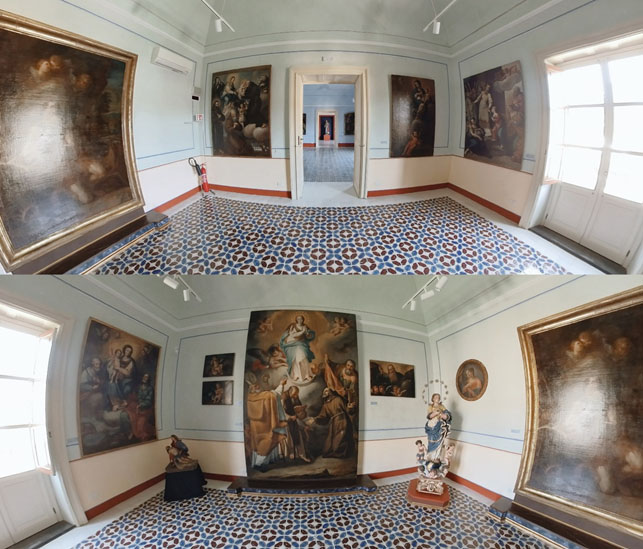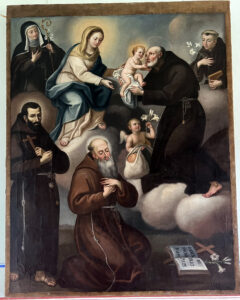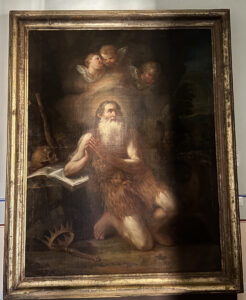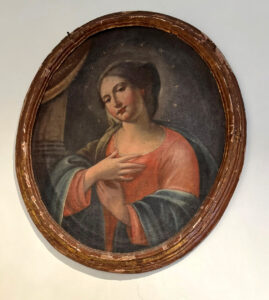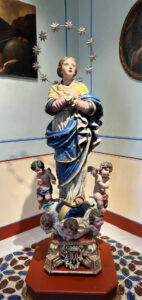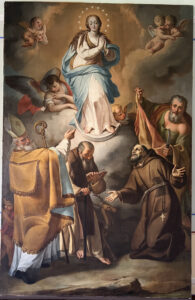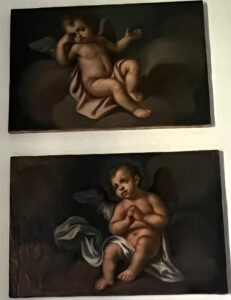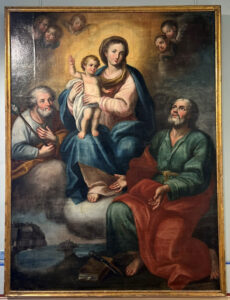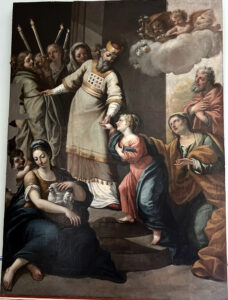Room III
Room III is dedicated to Bishop Giuseppe Coppola, a cultured prelate from Palermo who governed the diocese of Lipari from 1778 to 1789.
In addition to dedicating himself to the training of the clergy, the prelate brought a number of schoolteachers to the island to provide for the education of girls, and undertook the construction of a building to house orphans and street women who wanted to change their lives.
Moreover, to solve the constant problem of water shortage, he had three large cisterns built, which Lazzaro Spallanzani, a biologist priest from Emilia, also saw and appreciated when he visited the Aeolian Islands in 1788.
Bishop Coppola also had numerous olive trees planted on the island and introduced the cultivation of mulberry trees, which proved to allign easily, as well as a particular type of red Opuntia ficus indica (the so-called prickly pear), brought from Palermo.
In 1782, Coppola moved a ‘Seminary of Letters’ into the enclosure of the bishop’s palace, which he wanted open to the public, just as his library was open to the public, and he also created an antiquarium where he collected various archaeological finds.
His attention was obviously also turned to the restoration of churches. In the Cathedral, in particular, he arranged some altars and had the large altarpieces made by the Palermo painter Antonio Mercurio, which can still be admired there today.
The Bishop died in 1789 and was buried in the Cathedral next to the altar of the Crucifix, in a marble sarcophagus surmounted by a statue depicting him offering charity to a child.
In this room dedicated to him, there are 10 oil paintings on canvas and two wooden statues, works that still refer to various stages of the 18th century and thus constitute the chronological continuation of ROOM II.
The main works are:
the Madonna of Milk, by an unknown 18th century painter, from the Church of the Madonna delle Grazie on Lipari. It is a work of good workmanship depicting the Virgin on a throne of clouds holding the Child in her arms, who collects, in a small glass cruet, the milk flowing from the Mother’s womb. On the lower left is Saint Bernard of Corleone, who at the time of the painting had not yet been canonised but whose reputation for holiness was already widespread due to his numerous miracles;
a Presentation of the Virgin Mary in the Temple, painted by a painter from the first half of the 18th century, also well executed and reminiscent in some respects of Romanelli’s Presentation of St. Peter in the Vatican;
a Holy Family and St. Bartholomew, painted in 1793, as indicated on the same canvas, by an unknown artist active in the Aeolian Islands, as evidenced by other paintings attributable to the same hand. It comes from the Church of the Madonna delle Grazie in Lipari and reproduces, in the lower register, a view of the town at the time;
an Immaculate among Saints and cherubs, from the Church of the Capuchins at the Camposanto in Lipari. The author of the large altarpiece is unknown, although there is a detailed description of the work from the early 19th century, in which it is attributed to Capuchin Father Fedele da S. Biagio with the date 1794.
a S. Onofrio, dated 1743 and signed Giovanni Barbera, originally in the Church of Santa Maria dei Bianchi at Castello di Lipari. The anchorite saint, who renounced the comforts of his nobility, as indicated by the crown and sceptre in the bottom left-hand corner, is depicted praying and, as per tradition, dressed in skins and foliage.
a Madonna and Child with Franciscan Saints, from the 18th century, in which several saints of the order founded by St. Francis, towards whom there must have been greater devotion in the area, are depicted together. A description of the work is provided by Canon Rodriguez, who saw it in the Capuchin church on Lipari. It is attributed to the priest Giuseppe Russo, from Barcellona di Sicilia;
a sculpture depicting La Pietà from the church of S. Lucia di Lipari, in carved and painted wood, signed by Francesco Di Nardo, a Neapolitan sculptor documented between 1704 and 1776 in Basilicata, Calabria, Campania, Puglia, Molise, Sardinia and Spain.
Other works present are:
a valuable sculpture in carved and painted wood of The Immaculate Conception, by the Neapolitan artist Salvatore Cepparulo, dated 1873 and once in the Bishop’s private chapel.
Some small canvases, oil on canvas, from the Capuchin Church on Lipari, depicting God the Father, attributed to Capuchin Father Fedele da S. Biagio and dated 1794, and two weeping putti, from the altar of the Miraculous Crucifix.

